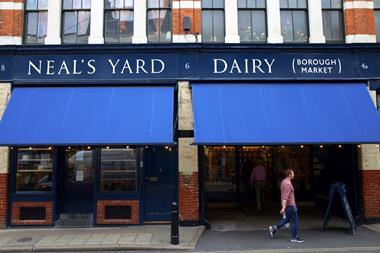Retail crime is on the rise, and with it violent and abusive incidents towards shopworkers. Is the Retail Crime Action Plan enough to tackle it?
It’s 10 years since the police walked away from retail crime. The Anti-Social Behaviour, Crime & Policing Act 2014 meant any shoplifting below £200 in value did not need to be investigated. At least that’s how the police interpreted it.
The result has been soaring retail theft, violence and abuse towards shopworkers, made only worse by the pandemic and the cost of living crisis.
But terrifying scenes captured on CCTV shamed the ex-government into action, resulting in the launch of the Retail Crime Action Plan last October – a government strategy aimed at bringing together retailers and police to tackle the rise of shoplifting and the often violent incidents that come with it at last.
So one year on, what difference has the plan made, if any? Is the police finally taking retail crime seriously? And what more needs to be done on both sides to crack down on this plague?
One thing is for sure: the statistics are criminal: according to the BRC’s Retail Crime Survey 2024, shop theft more than doubled to 16.7 million incidents in 2023, while acts of violence and abuse towards staff – often triggered by encounters with thieves – were up 50% to 1,300 incidents a day.
Shopworkers have been spat on, threatened with HIV-infected needles, held at knifepoint, followed home and more, the survey found. Yet police have consistently ignored retail incidents, with 61% of retailers rating police responses as poor or very poor, up from 44% the previous year, the BRC survey found.
This lack of action also makes retailers reluctant to report incidents, says BRC assistant director of regulatory affairs Graham Wynn. “And if the police do respond, there are seldom adequate consequences for perpetrators.”
So what does the plan entail? One of the plan’s pillars was Project Pegasus, a business and policing partnership that has seen some of the UK’s top retailers funding a new team of specialist officers and analysts to work within Opal – the national intelligence unit for organised acquisitive crime. This intelligence helps to build a holistic picture of where shoplifting gangs are operating and what stores they’re targeting.
16.7m
Incidents of retail theft in 2023, up from eight million the previous year
£1.8bn
Retail losses from customer theft in 2023 – the highest ever
£1.2bn
Cost of retail crime prevention measures in 2023, up from £720m the previous year
£3.3bn
Overall cost of retail crime including crime prevention measures in 2023, almost double the previous year
36%
Percentage of incidents of violence and abuse reported to police by retailers in 2023
1,300
Daily incidents of violence and abuse against retail staff in 2023
61%
Percentage of retailers that rated police response as ‘poor’ or ‘very poor’ in 2023, up from 44% the previous year
£55k
Value of goods stolen from Boots stores across Wales by one individual, before they were caught and sentenced to four years in prison
59%
Percentage of retail crime incidents where violence was used that were attended by police in May 2024
3%
Percentage of shop thefts reported to the police
The plan is working
Already there’s evidence the plan is working. From May to August, Opal identified 152 individuals linked to organised retail crime – and facilitated 23 arrests of high-harm offenders.
“Project Pegasus is progressing really well, with some very good interaction between police, retailers and the security industry,” says chief superintendent Alex Goss, the National Police Chiefs’ Council (NPCC) lead for retail crime.
One offender was recently sentenced to four years in jail after stealing over £55,000 of goods from Boots stores across Wales. Another, operating across at least 16 police force areas, stole over £33,000 worth of high-value goods such as electricals, fragrances and baby products. He received a 16-month custodial sentence.
“Organised crime groups may be targeting one retailer using the same tactics across multiple regions, and without a national team to bring together that information, we have had several police forces each looking into the same group,” says Opal head of intelligence Stephanie Coombes.
“Our role is vital in centralising intelligence, building strong evidence packages and then working with the relevant forces to deal with these high-harm offenders. For far too long these groups have been damaging retailers and communities with thefts reaching hundreds of thousands of pounds, and we are now quite literally ensuring they have nowhere to hide.”
“If there’s more resource required that isn’t there, then all it does is jam up the courts and slow the process down”
The Retail Crime Action Plan also said police would prioritise attendance at shoplifting instances where violence had been used or an offender had been detained. And this metric is also showing signs of improvement, according to Co-op campaign and public affairs director Paul Gerrard.
“When Co-op’s specialist undercover team detained an offender, police were turning up 22% of the time before October 2023, which means 78% of the time we had to let them go. Since October 2023, police are now turning up 66% of the time. That shows police are recognising the seriousness of this issue and beginning to change their response rates – and the police deserve credit for that.”

At a pan-retailer level, the NPCC has been carrying out quarterly ‘dip samples’ of police force data. In its latest audit, in which 30 out of 43 police forces responded, 1,470 retail crimes were reviewed during May. It showed police attended 59% of occurrences where violence was used. When police did not attend, the most common reason was “offender had left the scene” (57%). And when a suspect had been detained by the store, which was 22% of the time, there was an 83% attendance rate by police. The audit also revealed that 33% did not respond due to “unit diverted/higher priority call”, followed by 24% when the offender was “let go before calling the police”.
The NPCC’s Goss says the figures “give us a measure of what we’re doing, a measure of success, and information to feed back to the retailers. Sometimes perception is reality, but the data gives you a different picture.”
The data challenge
There are obvious issues with the audits, however. First, it’s not mandatory for police forces to respond, resulting in a lack of information on performance nationally. Second, there is no easy or quick way to collate the original data – which is a key reason why some forces can’t respond to the audits in time.
The NPCC says it’s looking at ways to automate the data and make it easier to collect. University of London professor of criminology Emmeline Taylor agrees a more systematic framework is needed. “At the push of a button, police forces should be able to say: ‘OK, this is how we performed’,” she says. “The Retail Crime Action Plan needs to be measured by key performance indicators, then each police force would periodically produce a report showing how they’ve performed against those metrics every quarter. This [would] make it easier to track and monitor retail crime.”
Read more:
-
Shop thefts recorded by police ‘a drop in the ocean’ compared with retail’s experience
-
Iceland is right to flag retail crime measures, but police support is a must
-
Au Vodka replaces stock after Tenby store shoplifting video goes viral
But there’s another problem: this data is limited to retailers who have reported to the police. When comparing industry surveys to police retail crime records, less than 3% of shop thefts are reported, says Taylor.
“So because accurate shop theft data doesn’t reach the radar of the police and crime commissioner (PCC) and chief constable, it means they aren’t allocating the time and resources to tackle it,” she adds. “This means some criminals are managing to operate with impunity. If they’re not reported on, you can’t join the dots, so it becomes a very dark picture.”
It’s hard to blame the retailers, though. According to the Association of Convenience Stores (ACS) Crime Report 2024, retailers don’t report because of a perceived lack of interest from police, and retailers are dissatisfied with the time it takes to file and process reports. But there are time-saving solutions out there. Sussex Police, for example, has led a pilot using ‘one-touch reporting’ alongside The Co-op and the National Business Crime Solution (NBCS). This not-for-profit initiative takes incident reports from the Co-op’s system and feeds it directly into the force’s ‘Niche’ crime recording application, reducing the time needed to report an incident from about 30 minutes to 90 seconds.

The trouble with the £200 threshold
The ‘£200 rule’ has invoked much controversy over the years. In short, section 176 of the Anti-social Behaviour, Crime & Policing Act 2014 was introduced to deal with high volumes of “low-value” cases more swiftly – by making shop theft worth £200 or less a summary-only offence.
It meant these offences could be handled by the police directly, with offenders given the option to plead guilty by post rather than clogging up the Crown Court.
Ultimately, though, it’s given offenders ‘a licence to steal’ if they do not take goods worth more than this amount, with police almost entirely ceasing the punishment of shoplifters since the law’s introduction.
According to The Times analysis of data published by the Home Office, Ministry of Justice and police, the use of cautions to punish shoplifters has dropped by 87.2% since 2014 to 2,077 in the past year. The number of shoplifters pursued through the courts has also declined, with 28,955 convictions over the past year, compared with 71,998 a decade ago.
Fixed Penalty Notices (FPNs) can also be issued by the police as an alternative to a prosecution, but even these are rarely used by police in dealing with shoplifting. The Times data showed 431 shoplifters were handed FPNs in the year to March – a shocking 97.8% drop from a decade ago.
The drop in FPNs could be explained by their ineffectiveness, explains Craig MacKenzie of Forbes Solicitors. “FPNs can certainly deal with low-level thefts more quickly. However, they’ve arguably become pointless because they’re often issued to drug addicts who are stealing to feed their addiction. They aren’t concerned about FPNs, meaning many are never paid.”
Labour has set out to scrap the £200 rule in a bid to “end the shameful neglect” of shoplifting by police it says. Scrapping the threshold could act as a strong deterrent, but more funding will be required to ensure “low-level” theft is dealt with.
Data sharing
Sussex, Merseyside and Thames Valley police forces are also encouraging retailers to use data-sharing system Disc, where they can view ‘galleries’ of offenders, submit incident reports, provide intelligence, help name unidentified CCTV images, and get alerts about incidents in their areas. Sussex PCC Katy Bourne, for example, says nearly 11,000 offender images have been shared via Disc in her area in the past year.
Iceland boss Richard Walker recently called on the government to change the law so images and videos could be shared on local WhatsApp groups to help stop prolific shoplifters. In guidance to retailers, Melissa Mathieson, the Information Commissioner’s Office director of regulatory policies, told The Times: “If neighbouring retailers want to share images between one another, they should consider putting an agreement in place to all use only secure work devices and activate auto-delete settings. Without this, images could end up in personal phones and uploaded to personal cloud backups.”

Another obstacle preventing retailers reporting is a lack of confidence there will be a follow-up investigation. “When retailers are repeatedly targeted by the same offenders without seeing effective action, they may become disheartened and stop reporting incidents,” says NBCS head of local services Sarah Bird.
That’s why the action plan set out advice for retailers on how to provide the best possible evidence for police to pursue. It says retailers should send CCTV footage of the whole incident and an image of the shoplifter via a digital evidence management system (DEMS) as quickly as possible after an offence has been committed. Where CCTV or other images are secured, police will run this through the Police National Database using facial recognition to further aid efforts to identify and prosecute offenders.
“Sharing information is critical to crime prevention, and the National Business Crime Centre (NBCC) is working with data protection colleagues at the NPCC to develop a simplified national process to allow sharing of intelligence between police and retailers,” says Patrick Holdaway, lead of the NBCC. “This will help improve identification of offenders and, where appropriate, the sharing of information that allows banning notices to be issued.”
Most police forces have adopted DEMS to streamline the management of evidence. The system enables police forces to send businesses a link where they can upload CCTV, pictures and statements into a secure system in the cloud. But many older CCTV systems can’t utilise this technology, so it’s critical retailers upgrade their equipment, says Holdaway.
“More perpetrators must be brought to justice. Only one in nine cases have made it to a courtroom”
The NBCC has also worked with the Crown Prosecution Service and police forces to develop a standard witness statement, which retailers can use when submitting CCTV evidence using DEMS. A key question is whether the police are prepared to handle an increased volume of reports as they become digitally standardised.
“There’s only so much that can be done, because what we’re not seeing is a huge and immediate change in police resource,” says ACS communications director Chris Noice. “The Labour manifesto talks about thousands of new officers, so that’s a potential point of progress, but we’ve not seen it yet.”
It appears the sector needs to strike a delicate balance, ensuring the benefits of enhanced reporting do not overwhelm police capabilities. Taylor suggests setting up a national retail crime intelligence bureau – similar to the one used in tackling fraud.
Read more on food fraud:
-
Illegal meat import concerns grow as Defra slashes border team budget
-
One in four cigarettes smoked in UK now illicit
-
‘Lethal’ Glen’s Vodka highlights growing food fraud concerns
-
Is the threat of food fraud growing?
“About 10 years ago, fraud was rapidly increasing, and because the police couldn’t deal with it, they separated fraud from the police so they didn’t have to use up important time and resources,” says Taylor. “The intelligence could be collated by this department and then all the serious and prolific cases could be triaged. A national intelligence bureau would remove the potential of overwhelming the police with the sheer volume of shop theft incidents and target resources to those with ‘solvability factors’ – in essence, the bureau would establish whether there’s a realistic prospect of identifying the offender before passing to the police.”
Identifying offenders is indisputably the goal, and custodial sentences are an obvious route of punishment – especially when violence has been used. But should it be the only method when prosecuting repeat offenders?
If you concentrate on repeat offenders, you’re likely to have a bigger impact as this cohort accounts for 80% of retail crime, NPCC data shows. But as the number one motivation for shoplifting is to fund drug or alcohol addiction, according to the ACS, a short-term prison sentence is unlikely to solve these substance issues.
“The revolving door of prison is spinning at a dizzying pace for some offenders. You’ve served 37 prison sentences, but maybe it’ll be the 38th that changes things? Unlikely. We need to stop looking at social problems through a criminal lens,” says Taylor.

Why a standalone offence will make a difference
Retailers have awaited the bill that will make attacking a shopworker a standalone offence for year. The Labour government has promised to introduce these powers under the new Crime & Policing Bill – but it’s a bittersweet victory for shopworkers.
The new crime bill isn’t likely to become law until at least summer 2025. So, as Co-op’s Paul Gerrard says, that would make it “a year after it should’ve been, and three years after it could’ve been”.
It’s true the courts still have powers to impose an aggravating factor when an offender has attacked a shopworker under the Police, Crime, Sentencing & Courts Act 2022. However, aggravating factors are not recorded in the same way offences themselves are, which makes it difficult to track both the amount of times the aggravating factor has had an influence on a sentencing decision and how effective it was.
That’s a clear indicator as to why a standalone offence is critical. Not only will it act as a deterrent to offenders, it will make it easier to monitor and record the number of offences against shopworkers.
And, ultimately, it is symbolic. As ACS’s Chris Noice says: “It will empower colleagues and give them a status of being recognised.”
Scotland’s Protection of Workers Act 2021 is a case in point. The act makes it a statutory offence to assault, threaten or abuse a retail worker as they’re going about their job.
And Police Scotland revealed earlier this year there had been over 10,000 cases reported by retailers under the act so far.
But there’s still work to be done. Due to a backlog in the courts, just 11.6% of reported cases by retailers resulted in conviction since the law’s introduction by January, figures by the Crown Office & Procurator Fiscal Service (COPFS) showed.
As SGF CEO Pete Cheema says: “The proportion of perpetrators successfully being brought to justice needs to be much higher, with only one in nine cases having made it to a courtroom so far.”
Social interventions
The Offender to Recovery initiative, led by West Midlands police officer Stuart Toogood, might provide a solution. Funded by the force’s PCC and donations from retailers including Co-op and B&Q, the programme focuses on the underlying causes of crime by making sure people who are stealing to fund an addiction are treated in a rehab facility or recovery communities. It also offers heroin addicts a monthly injection called Buvidal, an opioid blocker supplied by charity Change, Grow, Live, which is “slow releasing, calms them down and takes that craving away”, says Toogood.
“We don’t just put them into rehab and walk away,” he adds. “We keep that link there and ensure they get aftercare. We might also help them get some voluntary work, look at education or employment.”

Improving lives is a clear motive behind the initiative, but the impact on retail crime is another benefit. “One lady we’ve been dealing with had been offending for 29 years and was in and out of prison more than 25 times,” Toogood says. “She would use £300 a day on heroin and steal at least £1,000 worth a day from retailers. In the 10 months she’s been on Buvidal and not offended, you’re looking at £300k prevented from retail theft and almost £100k not going into the drugs market.”
It seems certain such social interventions are part of the winning formula required to break the reoffending cycle. “Our programme is not a magic wand, it’s a hard slog,” says Toogood. “But with patience and dedication, the rewards are evident.”
Co-op’s Gerrard is clear a multifaceted problem such as retail crime requires a multifaceted solution.
“What are the options available to the criminal justice systems that will prevent reoffending? Sometimes that will be a custodial sentence, sometimes a suspended sentence, but it might also be rehab, training and development or restorative justice,” he says. “More than 60% of prisoners are reoffenders; if we really want to protect shopworkers and shops long term, we’ve got to have interventions that prevent reoffending.”

























No comments yet